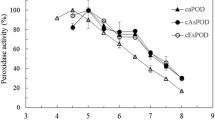Abstract
The poor stability of crude solutions of fusicoccin-binding sites, prepared from acetonedried microsomal fractions of spinach leaves, results from the attack by endogenous phosphatase and α-mannosidase. The addition of either of these enzymes to solubilised binding sites preincubated with [3H]fusicoccin promptly releases most of the bound radioactivity. A satisfactory stabilization of the crude preparations is obtained with fluoride added either during homogenization of the tissue, or immediately after solubilisation. The results indicate that the fusicoccin-binding sites are phosphorylated glycoproteins.
Similar content being viewed by others
Abbreviations
- FC:
-
fusicoccin
- Tris/Mes:
-
2-amino-2-(hydroxymethyl)-1,3-propanediol/2-(N-morpholino)ethanesulfonic acid
References
Aducci, P., Ascenzi, P., Ballio, A., Antonini, E. (1983) Catalytic properties of plant proteinases. A comparison between serine and thiol enzymes: spinach leaf proteinase, papain, ficin and bromelains. Special Workshop on Proteinase Action, Debrecen, Hungary, 29–31 August 1983. Publishing House, Hungarian Academy of Sciences, Budapest
Aducci, P., Ballio, A., Federico, R. (1982a) Solubilisation of fusicoccin binding sites. In: Plasmalemma and tonoplast. Their function in the plant cell, pp. 279–284, Marmé, D., Marrè, E., Hertel, R., eds. Elsevier Biomedical Press, Amsterdam
Aducci, P., Ballio, A., Federico, R., Montesano, L. (1982b) Studies on fusicoccin-binding sites. In: Plant growth substances 1982, pp. 395–404, Wareing, P.F., ed. Academic Press, London New York
Aducci, P., Federico, R., Ballio, A. (1980a) Fusicoccin receptors. Evidence for endogenous ligand. Planta 148, 208–210
Aducci, P., Federico, R., Ballio, A. (1980b) Interaction of a high molecular weight derivative of fusicoccin with plant membranes. Phytopathol. Mediterr. 19, 187–188
Ballio, A., Carilli, A., Santurbano, B., Tuttobello, L. (1968) Produzione di fusicoccina in scala pilota. Ann. Ist. Sup. Sanità 4, 317–332
Ballio, A., Federico, R., Pessi, A., Scalorbi, D. (1980) Fusicoccin binding sites in subcellular preparations of spinach leaves. Plant Sci. Lett. 18, 39–44
Cohen, S., Ushiro, H., Stoscheck, C., Chinkers, M. (1982) A native 170,000 epidermal growth factor receptor-kinase complex from shed plasma membrane vesicle. J. Biol. Chem. 257, 1523–1531
Colegate, S.M., Dorling, P.R., Huxtable, C.R. (1979) A spectroscopic investigation of swainsonine: an α-mannosidase inhibitor isolated from Swainsona canescens. Aust. J. Chem. 32, 2257–2264
Crasnier, M., Ricard, J., Noat, G. (1982) pH-regulation of acid phosphatase of plant cell walls. An example of adaptation to the intracellular milieu. FEBS Lett. 144, 309–312
den Tandt, W.R. (1972) Acid hydrolases in uncultured amniotic fluid cells. Clin. Chim. Acta 40, 199–204
Dixon, M. (1953) The determination of enzyme inhibitor constants. Biochem. J. 55, 170–171
Dorling, P.R., Huxtable, C.R., Colegate, S.M. (1980) Inhibition of lysosomal α-mannosidase by swainsonine, an indolizidine alkaloid isolated from Swainsona canescens. Biochem. J. 191, 649–651
Kang, M.S., Elbein, A.D. (1983) Mechanism of inhibition of jack bean α-mannosidase by swainsonine. Plant Physiol. 71, 551–554
Kasuga, M., Fujita-Yamaguchi, Y., Blithe, D.L., Kahn, C.R. (1983) Tyrosine-specific protein kinase activity is associated with the purified insulin receptor. Proc. Natl. Acad. Sci. USA 80, 2137–2141
Kasuga, M., Karlsson, T.A., Kahn, C.R. (1982) Insulin stimulates the phosphorylation of the 95,000-Dalton subunit of its own receptor. Science 215, 185–187
Li, Y.T. (1967) Studies on the glycosidases in jack bean meal. I. Isolation and properties of α-mannosidase. J. Biol. Chem. 242, 5474–5480
Li, Y.T., Li, S.C. (1972) α-Mannosidase, β-N-acetylhexosaminidase, and β-galactosidase from jack bean meal. Methods Enzymol. 28, 702–713
Lowry, O.H., Rosebrough, N.J., Farr, A.L., Randall, R.J. (1951) Protein measurement with the Folin phenol reagent. J. Biol. Chem. 193, 265–275
Molineux, R.J., James, L.F. (1982) Loco intoxication: indolizidine alkaloids of spotted locoweed (Astragalus lentiginosus). Science 216, 190–191
Neufeld, E.F., Ashwell, G. (1980) Carbohydrate recognition systems for receptor-mediated pinocytosis. In: The biochemistry of glycoproteins and proteoglycans, pp. 252–257, Lennarz, W.J., ed. Plenum Press, New York London
Pesci, P., Cocucci, S.M., Randazzo, G. (1979a) Characterization of fusicoccin binding to receptor sites on cell membranes of maize coleoptile tissues. Plant Cell Environ. 2, 205–209
Pesci, P., Tognoli, L., Beffagna, N., Marrè, E. (1979b) Solubilisation and partial purification of a fusicoccin receptor complex from maize microsomes. Plant Sci. Lett. 15, 313–322
Polya, G.M., Davies, J.R. (1983) Resolution and properties of a protein kinase catalyzing the phosphorylation of a wheat germ cytokinin-binding protein. Plant Physiol. 71, 482–488
Rao, K.P., Randall, D.D. (1980) Plant pyruvate dehydrogenase complex: inactivation and reactivation by phosphorylation and dephosphorylation. Arch. Biochem. Biophys. 200, 461–466
Refeno, G., Ranjeva, R., Boudet, A.M. (1982a) Modulation of quinate: NAD+ oxidoreductase activity through reversible phosphorylation in carrot cell suspensions. Planta 154, 193–198
Refeno, G., Ranjeva, R., Fontaine-Delvare, S., Boudet, A. M. (1982b) Functional properties of protein kinase(s) and phosphatase(s) converting quinate: NAD+ oxidoreductase into active and deactivated forms in carrot cell suspension cultures. Plant Cell Physiol. 23, 1137–1144
Robinson, D.B., Glew, R.H. (1980) Acid phosphatase in Gaucher's desease. Clin. Chem. 26, 371–382
Russell, D.W., Dix, W.D. (1981) In vitro inactivation and activation of pea seedlings HMG-CoA reductase (Abstr.). Plant. Physiol. [Suppl.] 67, 152
Stout, R.G., Cleland, R.E. (1980) Partial characterization of fusicoccin binding to receptor sites on oat root membranes. Plant Physiol. 66, 353–359
Trewavas, A. (1976) Post-translational modification of protein by phosphorylation. Annu. Rev. Plant Physiol. 27, 349–374
Author information
Authors and Affiliations
Additional information
This paper is dedicated to the memory of Eraldo Antonini, deceased 19 March 1983
Rights and permissions
About this article
Cite this article
Aducci, P., Ballio, A., Fiorucci, L. et al. Inactivation of solubilised fusicoccin-binding sites by endogenous plant hydrolases. Planta 160, 422–427 (1984). https://doi.org/10.1007/BF00429758
Received:
Accepted:
Issue Date:
DOI: https://doi.org/10.1007/BF00429758




